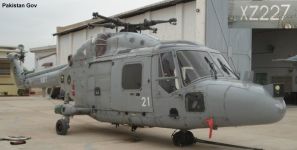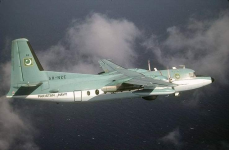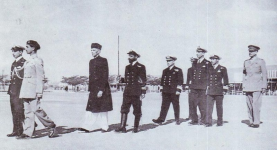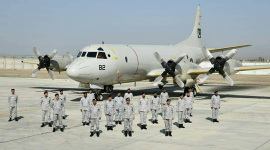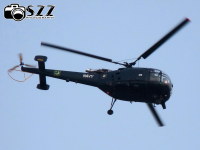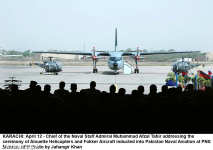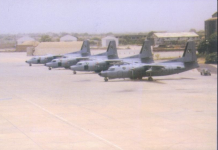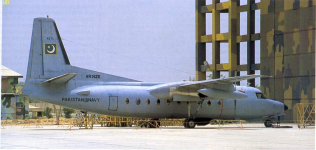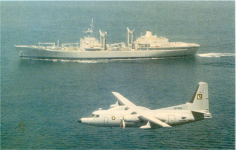ghazi52
Think Tank Analyst
- Mar 21, 2007
- 116,854
- 167,084
- Country of Origin

- Country of Residence

- Thread starter
- #46

ACTIVE : 4 OPERATIONAL SPEED : 355 kt (658 km/h).
SERVICE CEILING : 32,800 ft (10,000 m).
RANGE A/C : 4,855 n miles (8,995 km).
ROLE/WEAPON SYSTEMS :
Long-range MR/ASW cover for Arabian Sea; ex-French and Dutch stock. Upgraded in 1992-93. Three more acquired in 1994 for spares. Sensors: Thomson-CSF Ocean Master radar, Thomson-CSF DR 3000A ESM, MAD, sonobuoys, Sadang 1C sonobuoy signal processor. Weapons: ASW; nine Mk 46 or244/S torpedoes, Mk 11 depth bombs, mines. ASV; two AS 12 or AM 39 Exocet missiles.
PROGRAMME:
On 31 July 1974, Dassault-Breguet delivered the 18th Breguet 1150 Atlantic maritime patrol aircraft ordered by the Italian government. This completed the production programme for 87 operational Atlantics of the basic type, made up of 40 aircraft for the French Navy, three of which were passed on to Pakistan. Manufacture was shared by companies in France, Germany, Italy and Pakistan, with additional airframe components supplied by the Belgian ABAP group and some equipment from the USA and UK.
UPGRADES:
Alenia: See separate entry in Italy section. Dornier: See separate entry in Germany section. Germany: In late 1996 the German government announced that it was developing a requirement for a life-extension programme for the German Navy's fleet of 18 Atlantic 1 maritime patrol aircraft. The programme will add 12,000 hours to the airframe life to keep the aircraft in service until 2010. The requirement also includes retrofitting the following equipment: a Forward-Looking InfraRed (FLIR) sensor as well as improved navigation, communications (GMDSS) and Electronic Support Measures (ESM) systems. All equipment is to be Commercial Off The Shelf (COTS).
Thomson-CSF:
Awarded contract to upgrade Pakistan Navy Atlantic 1 aircraft with the AMASCOS mission system (see separate entry in France section).
OPERATORS:
Versions of the Atlantic are in service with the armed forces of the following countries: Germany (19); Italy (18) and Pakistan (4). The following description applies to the basic version.
DESIGN FEATURES:
Cantilever mid-wing monoplane. Wing section NACA 64 series. Dihedral on outer wings only. Fixed-incidence tailplane.
FLYING CONTROLS:
Conventional all-metal ailerons actuated by SAMM twin-cylinder jacks. All-metal slotted flaps, with bonded light-alloy honeycomb filling, over 75 per cent of span. Three hinged spoilers on upper surface of each outer wing, forward of flaps. Metal airbrake above and below each wing. No trim tabs. Tail unit control surfaces operated through SAMM twin-cylinder jacks. No trim tabs.
STRUCTURE:
All-metal three-spar fail-safe structure, with bonded light-alloy honeycomb skin panels on torsion box and on main landing gear doors. The fuselage is an all-metal `double-bubble' fail-safe structure, with bonded honeycomb sandwich skin on pressurised central section of upper fuselage, weapons bay doors and nosewheel door. The tail unit is a cantilever all-metal structure with bonded honeycomb sandwich skin panels on torsion boxes.
SYSTEMS:
Kleber-Colombes pneumatic de-icing boots on wing leading-edges. Kleber-Colombes pneumatic de-icing boots on tail unit leading-edges.
LANDING GEAR:
Retractable tricycle type, supplied by Messier-Hispano, with twin wheels on each unit. Hydraulic retraction, nosewheels rearward, main units forward into engines nacelles. Kleber-Colombes dimpled tyres, size 956 x 319-392 mm on mainwheels, 637 x 190-319 mm on nosewheels. Tyre pressures: main 9.52 bars (138 lb/sq in), nose 6.07 bars (88 lb/sq in). Messier-Hispano disc brakes with Maxaret anti-skid units.
POWER PLANT:
Two 4,553 kW (6,106 ehp) SNECMA-built Rolls-Royce Tyne RTy.20 Mk 21 turboprop engines, each driving a Ratier-built HSD four-blade constant-speed propeller. Six integral fuel tanks with total capacity of 21,000 litres (5,547 US gallons; 4,619 Imp gallons). Provision for wingtip tanks to be fitted.
ACCOMMODATION:
Normal flight crew of 12 comprising observer in nose; pilot and co-pilot on flight deck; a tactical co-ordinator, navigator, two sonobuoy operators, and radio, radar and ECM/MAD/Autoycus operators in tactical compartment; and two observers in beam positions.
On long-range patrol missions a further 12 crew can be carried as relief crew. The upper, pressurised section of the fuselage, from front to rear, comprises the nose observer's compartment, flight deck, tactical operations compartment, rest compartment for crew, and beam observers' compartment.
SYSTEMS:
SEMCA air conditioning and pressurisation system. Hydraulic system pressure 207 bars (3,000 lb/sq in). Electrical system provides 28.5 V DC, 115/200 V variable-frequency AC and 115/200 V stabilised-frequency AC. AirResearch GTCP 85-100 APU in starboard side of front fuselage, adjacent radar compartment, for engine starting and ground air conditioning, can also power one 20 kVA AC alternator and one 4 kW DC generator for emergency electrical power supply.
ARMAMENT AND OPERATIONAL EQUIPMENT:
Main weapons carried in bay in unpressurised lower fuselage. Weapons include all NATO standard bombs, 175 kg (385 lb) US or French depth charges. HVAR rockets, homing torpedoes, including types such as the Mk 46 Brush or LX.4 with acoustic heads, or four underwing air-to-surface missiles with nuclear or high-explosive warheads. Electronic equipment includes a retractable Thomson-CSF radar installation, a MAD tailboom and an electrical countermeasures pod at the top of the tailfin. Sonobuoys are carried in a compartment aft of the main weapons bay, while the whole of the upper and lower rear fuselage acts as a storage compartment for sonobuoys and marker flares.
Compartment for retractable Thomson-CSF radar `dustbin' forward of the main weapons bay. Forward of this, the lower nose section acts as additional storage for military equipment and the APU. Weapons system includes Plotac optical tactical display, 80 x 80 cm (31.5 x 31.5 in) in size, consisting of separate tables for search display and localisation and attack display.
At 1:30,000 scale, this gives coverage of any area 21,950 x 21,950 m (72,000 x 72,000 ft) to an accuracy of 1 mm (that is less than 30.5 m; 100 ft at that scale). Heading references provided by duplicated gyrosopic platforms of the 3-gyro (1° of freedom) 4-gimbals type, with magnetic compasses as back-up system. Janus-type Doppler has stabilised antenna and works in the Ke band to provide direct indication of ground speed and drift. In case of failure an automatic switch is made to the air data system.
The analogue type navigation computer is accurate to 0.25 per cent. The MAD is of the atomic resonance type and uses light simulation techniques. Plotac system has provision to accept additional detectors. Radar has `sea-return' circuits and stabilised antenna enabling it to detect a submarine snorkel at up to 40 n miles (75 km; 46 miles) even in rough seas.
Thomson-CSF AMASCOS multisensor system
Type: Maritime sensor (air).
Description
The AMASCOS (Airborne MAritime Situation COntrol System) is a family of integrated maritime patrol and surveillance mission systems, designed for building up and updating tactical situations in real time and as a decision aid for operators. The modular systems can be integrated on any type of fixed-wing aircraft or helicopter.
The typical AMASCOS configuration integrates Thomson-CSF equipment with the Ocean Master radar developed by Thomson-CSF and Daimler Benz Aerospace. The three versions of AMASCOS - AMASCOS 100, AMASCOS 200 and AMASCOS 300 - correspond to three broad categories of mission requirement ranging from simple maritime surveillance to anti-surface and anti-submarine warfare.
AMASCOS 100 is a lightweight configuration which weighs less than 250 kg. It includes radar and FLIR plus an integrated tactical computer and is suited for a wide range of missions, such as EEZ surveillance, search and rescue and law enforcement. It can be fitted on carrier or ground-based helicopters and light turboprop aircraft with one or two operators working in close co-ordination with the cockpit crew.
AMASCOS 200 adds ESM equipment to the AMASCOS 100 for anti-surface missions and can be extended to provide an Anti-Submarine Warfare (ASW) capability. It can be fitted to fixed- and rotary-wing aircraft in the 8 ton class. Two or three operators are required.
In addition to basic maritime patrol and surveillance functions, AMASCOS 300 offers both anti-surface and ASW capabilities and is suitable for naval operations command and control assignments. It can be installed on any maritime patrol aircraft in the 10 ton class and above. Three or more operators are required. The heart of the system is a dedicated tactical computer which collates and processes data from different sensors and other onboard equipment.
The system can be equipped with the following: the Ocean Master radar, Sextant Avionique Nadir Mk II inertial GPS, Thomson-CSF Optronique Chlio FLIR, Thomson-CSF DR 3000 ESM, Thomson-CSF Link W data link, Thomson Sintra ASM Sadang 1000 sonobuoys, Thomson Sintra ASM HS 312S dipping sonar and Sextant Avionique MAD Mk III.
Operational status
In 1994 the Indonesian Navy chose AMASCOS 100 for its CN-212 maritime patrol aircraft and NBO-105 helicopters. This will include the Ocean Master radar and Chlio FLIR. In January 1997 the Indonesian Navy ordered a further six systems for the CN-212.
In 1993 the Pakistan Navy chose AMASCOS to refurbish its four Atlantic long-range maritime patrol aircraft and three MPA Fokker 27. By the first quarter of 1996 the first aircraft modification was complete, including the integration of the Ocean Master Radar, the DR-3000-A ESM with interferometry, the SADANG 1001-C Acoustic Processor and a new radio-navigation set.
COMPANY NAME : Thomson-CSF Radars & Contremesures (RCM)
DIMENSIONS, EXTERNAL:
| Wing span | 36.30 m (119 ft 1 in) |
| Wing aspect ratio | 10.94 |
| Length overall | 31.75 m (104 ft 2 in) |
| Height overall | 11.33 m (37 ft 2 in) |
| Fuselage: Max width | 2.90 m (9 ft 6 in) |
| Max depth | 4.00 m (13 ft 1{1/2} in) |
| Tailplane span | 12.31 m (40 ft 4{1/2} in) |
| Wheel track | 9.00 m (29 ft 6{1/4} in) |
| Wheelbase | 9.44 m (31 ft 0 in) |
| Propeller diameter | 4.88 m (16 ft 0 in) |
DIMENSIONS, INTERNAL:
| Tactical compartment: Length | 8.60 m (28 ft 2{1/2} in) |
| Height | 1.93 m (6 ft 4 in) |
| Max width | 2.70 m (8 ft 10{1/2} in) |
| Rest compartment: Length | 5.10 m (16 ft 8{3/4} in) |
| Height | 1.93 m (6 ft 4 in) |
| Max width | 2.70 m (8 ft 10{1/2} in) |
| Beam observer's compartment: Length | 1.00 m (3 ft 3{1/4} in) |
| Main weapons bay: Length | 9.00 m (29 ft 6{1/4} in) |
| Height | 1.55 m (5 ft 1 in) |
| Height under wing | 1.00 m (3 ft 3{1/4} in) |
| Max width | 2.20 m (7 ft 2{1/2} in) |
AREAS:
| Wings, gross | 120.34 m{2} (1,295 sq ft) |
| Ailerons | 5.40 m{2} (58.0 sq ft) |
| Trailing-edge flaps (total) | 26.80 m{2} (288.4 sq ft) |
| Spoilers (total) | 1.66 m{2} (17.8 sq ft) |
| Fin | 16.64 m{2} (179.1 sq ft) |
| Rudder | 5.96 m{2} (64.1 sq ft) |
| Tailplane | 32.5 m{2} (349.7 sq ft) |
| Elevators | 8.28 m{2} (89.1 sq ft) |
WEIGHTS AND LOADINGS:
| Useful load | 18,551 kg (40,900 lb) |
| Max zero-fuel | 30,500 kg (67,252 lb) |
| Max T-O weight | 46,000 kg (101,430 lb) |
PERFORMANCE (at max T-O weight):
| Max level speed at high altitudes | 350 kt (648 km/h; 403 mph) |
| Cruising speed | 300 kt (556 km/h; 345 mph) |
| Service ceiling | 9,144 m (30,000 ft) |
| T-O to 10.7 m (35 ft), ISA | 1,500 m (4,925 ft) |
| T-O to 10.7 m (35 ft), ISA + 17°C, 15° flap | 1,700 m (5,575 ft) |
| Max range | 4,200 n miles (7,778 km; 4,838 miles) |
| Max endurance at patrol speeds of 169 kt (320 km/h; 195 mph) | 18 h |

